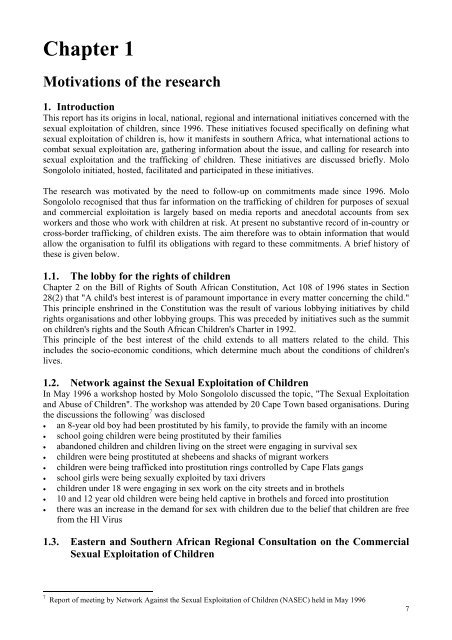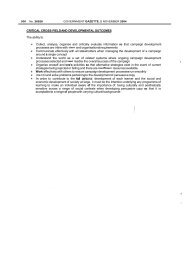The trafficking of children for purposes of sexual exploitation
The trafficking of children for purposes of sexual exploitation
The trafficking of children for purposes of sexual exploitation
Create successful ePaper yourself
Turn your PDF publications into a flip-book with our unique Google optimized e-Paper software.
Chapter 1<br />
Motivations <strong>of</strong> the research<br />
1. Introduction<br />
This report has its origins in local, national, regional and international initiatives concerned with the<br />
<strong>sexual</strong> <strong>exploitation</strong> <strong>of</strong> <strong>children</strong>, since 1996. <strong>The</strong>se initiatives focused specifically on defining what<br />
<strong>sexual</strong> <strong>exploitation</strong> <strong>of</strong> <strong>children</strong> is, how it manifests in southern Africa, what international actions to<br />
combat <strong>sexual</strong> <strong>exploitation</strong> are, gathering in<strong>for</strong>mation about the issue, and calling <strong>for</strong> research into<br />
<strong>sexual</strong> <strong>exploitation</strong> and the <strong>trafficking</strong> <strong>of</strong> <strong>children</strong>. <strong>The</strong>se initiatives are discussed briefly. Molo<br />
Songololo initiated, hosted, facilitated and participated in these initiatives.<br />
<strong>The</strong> research was motivated by the need to follow-up on commitments made since 1996. Molo<br />
Songololo recognised that thus far in<strong>for</strong>mation on the <strong>trafficking</strong> <strong>of</strong> <strong>children</strong> <strong>for</strong> <strong>purposes</strong> <strong>of</strong> <strong>sexual</strong><br />
and commercial <strong>exploitation</strong> is largely based on media reports and anecdotal accounts from sex<br />
workers and those who work with <strong>children</strong> at risk. At present no substantive record <strong>of</strong> in-country or<br />
cross-border <strong>trafficking</strong>, <strong>of</strong> <strong>children</strong> exists. <strong>The</strong> aim there<strong>for</strong>e was to obtain in<strong>for</strong>mation that would<br />
allow the organisation to fulfil its obligations with regard to these commitments. A brief history <strong>of</strong><br />
these is given below.<br />
1.1. <strong>The</strong> lobby <strong>for</strong> the rights <strong>of</strong> <strong>children</strong><br />
Chapter 2 on the Bill <strong>of</strong> Rights <strong>of</strong> South African Constitution, Act 108 <strong>of</strong> 1996 states in Section<br />
28(2) that "A child's best interest is <strong>of</strong> paramount importance in every matter concerning the child."<br />
This principle enshrined in the Constitution was the result <strong>of</strong> various lobbying initiatives by child<br />
rights organisations and other lobbying groups. This was preceded by initiatives such as the summit<br />
on <strong>children</strong>'s rights and the South African Children's Charter in 1992.<br />
This principle <strong>of</strong> the best interest <strong>of</strong> the child extends to all matters related to the child. This<br />
includes the socio-economic conditions, which determine much about the conditions <strong>of</strong> <strong>children</strong>'s<br />
lives.<br />
1.2. Network against the Sexual Exploitation <strong>of</strong> Children<br />
In May 1996 a workshop hosted by Molo Songololo discussed the topic, "<strong>The</strong> Sexual Exploitation<br />
and Abuse <strong>of</strong> Children". <strong>The</strong> workshop was attended by 20 Cape Town based organisations. During<br />
the discussions the following 7 was disclosed<br />
• an 8-year old boy had been prostituted by his family, to provide the family with an income<br />
• school going <strong>children</strong> were being prostituted by their families<br />
• abandoned <strong>children</strong> and <strong>children</strong> living on the street were engaging in survival sex<br />
• <strong>children</strong> were being prostituted at shebeens and shacks <strong>of</strong> migrant workers<br />
• <strong>children</strong> were being trafficked into prostitution rings controlled by Cape Flats gangs<br />
• school girls were being <strong>sexual</strong>ly exploited by taxi drivers<br />
• <strong>children</strong> under 18 were engaging in sex work on the city streets and in brothels<br />
• 10 and 12 year old <strong>children</strong> were being held captive in brothels and <strong>for</strong>ced into prostitution<br />
• there was an increase in the demand <strong>for</strong> sex with <strong>children</strong> due to the belief that <strong>children</strong> are free<br />
from the HI Virus<br />
1.3. Eastern and Southern African Regional Consultation on the Commercial<br />
Sexual Exploitation <strong>of</strong> Children<br />
7 Report <strong>of</strong> meeting by Network Against the Sexual Exploitation <strong>of</strong> Children (NASEC) held in May 1996<br />
7
















